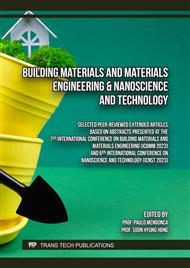[1]
F.Asdrubali; F.D'Alessandr. S. Schiavoni, A review of unconventional sustainable building insulation materials. Sustain. Mater. Technol. 2015, 4, 1–17.
Google Scholar
[2]
United Nations Energy Program, Energy Efficiency for Buildings, European Commission. (accessed 02 August, 2023), Available: https://ec.europa.eu/energy/en/topics/energy-efficiency/buildings
Google Scholar
[3]
R.S. Ribeiro: Oceanos, Infinito Azul, Biblioteca Pública e Arquivo Regional Luís da Silva Ribeiro – ISBN: 978-989-54455-6-1, Angra do Heroísmo (2023).
Google Scholar
[4]
A. Lima et al., "Essential Oils from Different Parts of Azorean Cryptomeria japonica (Thunb. ex L.f.) D. Don (Cupressaceae): Comparison of the Yields, Chemical Compositions, and Biological Properties", Applied Sciences, vol. 13, no. 14, p.8375, Jul. 2023.
DOI: 10.3390/app13148375
Google Scholar
[5]
E. Dias.; C. Araújo; J. Mendes.; R. EliaS; C. Mendes; C. Melo. Espécies Florestais das Ilhas—Açores. In Árvores e Florestas de Portugal; Silva, J.S., Ed.; Público, Comunicação Social, SA/Fundação Luso-Americana/Liga para a Protecção da Natureza: Lisboa, Portugal, 2007; Volume 6, p.199–254.
Google Scholar
[6]
S. Boran, M. Usta, and E. Gümüşkaya, "Decreasing formaldehyde emission from medium density fiberboard panels produced by adding different amine compounds to urea formaldehyde resin", International Journal of Adhesion and Adhesives, vol. 31, no. 7, p.674–678, (2011)
DOI: 10.1016/j.ijadhadh.2011.06.011
Google Scholar
[7]
B. Meyer, W. E. Johns, and J. K. Woo, "Formaldehyde release from sulfur-modified urea-formaldehyde resin systems", Journal for Forest Products, vol. 30, p.24–31, 1980.
Google Scholar
[8]
K. Lu, L. B. Collins, H. Ru, E. Bermudez, and J. A. Swenberg, "Distribution of DNA adducts caused by inhaled formaldehyde is consistent with induction of nasal carcinoma but not leukemia", Toxicological Sciences, vol. 116, no. 2, p.441–451, 2010.
DOI: 10.1093/toxsci/kfq061
Google Scholar
[9]
A. Bakatovich, F. Gaspar, N. Boltrushevich, Thermal insulation material based on reed and straw fibres bonded with sodium silicate and rosin, Construction and Building Materials, 2022.
DOI: 10.1016/j.conbuildmat.2022.129055
Google Scholar
[10]
N. Lakreb, U. Şen, E. Toussaint, S. Amziane, E. Djakab, H. Pereira, Physical properties and thermal conductivity of cork-based sandwich panels for building insulation, Construction and Building Materials, Volume 368, 2023.
DOI: 10.1016/j.conbuildmat.2023.130420
Google Scholar
[11]
N. Simões, R. Fino, A. Tadeu, Uncoated medium density expanded cork boards for building façades and roofs: Mechanical, hygrothermal and durability characterization Constr. Build. Mater., 200 (2019), pp.447-464
DOI: 10.1016/j.conbuildmat.2018.12.116
Google Scholar
[12]
S. Schiavoni, F. D׳Alessandro, F. Bianchi, F. Asdrubali, Insulation materials for the building sector: A review and comparative analysis, Renewable and Sustainable Energy Reviews, Volume 62, 2016, Pages 988-1011.
DOI: 10.1016/j.rser.2016.05.045
Google Scholar
[13]
E. Moretti, E. Belloni, F. Agosti, Innovative mineral fiber insulation panels for buildings: Thermal and acoustic characterization, Applied Energy, Volume 169, 2016, Pages 421-432.
DOI: 10.1016/j.apenergy.2016.02.048
Google Scholar
[14]
A. Korjenic, J. Zach, J. Hroudová, The use of insulating materials based on natural fibers in combination with plant facades in building constructions, Energy and Buildings, Volume 116, 2016, Pages 45-58.
DOI: 10.1016/j.enbuild.2015.12.037
Google Scholar



